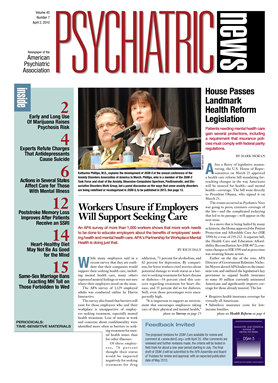Early use of marijuana appears to raise the risk for psychosis in adulthood, according to a report posted March 1 on the Web site of the Archives of General Psychiatry.
A prospectively studied birth cohort, using sibling pairs to diminish the effects of unmeasured confounding factors, has found that a longer duration since first use of cannabis—implying earlier first use—is associated with increased risk for psychosis at age 21.
Compared with those who had never used cannabis, young adults who commenced use around the age of 15 or younger were twice as likely to develop a nonaffective psychosis and four times as likely to have high scores on the Peters et al. Delusions Inventory (PDI).
Lead author John McGrath, M.D., said the use of sibling pairs in the analysis allowed for control of unmeasured residual effects that have compromised previous studies showing a correlation between earlier marijuana use and psychosis in adulthood.
“If you think early cannabis use causes schizophrenia, you would need to control for other factors that could also account for the association—that is, maybe the children of a parent with a mental illness are more prone to both using cannabis and having psychosis,” he told Psychiatric News. “The strength of using siblings is that you can reduce a fair chunk of this unmeasured, potential confounding noise, because the siblings have the same mother, probably the same father, and probably similar early life experiences.”
He is director of developmental neurobiology at the Queensland Centre for Mental Health Research in Australia.
Data for the study were drawn from the Mater-University Study of Pregnancy, a prospective study of 7,223 women and their singleton offspring who received antenatal care at a major public hospital in Brisbane, Australia, from 1981 to 1984. Follow-up of cohort members and their mothers occurred at five, 14, and 21 years.
Of the original sample, follow-up responses were obtained for 3,801 children at the 21-year mark. At that point, cannabis use was retrospectively assessed via a self-report questionnaire. Cohort members were asked, “In the last month, how often did you use cannabis, marijuana, pot, etc.?”
Options for response were “never used,” “used every day,” “every few days,” “once or so,” and “not in the last month.”
A second question sought the age at which use of cannabis began. Based on these variables and the cohort members' age at interview, researchers derived a measure of duration since first cannabis use. This variable was categorized into four levels, with those who had never used cannabis and those who had first used cannabis three, four, five, or six years previous.
At 21 years, associations between duration since first cannabis use and three psychosis-related outcomes—diagnosis of nonaffective psychosis, experience of hallucinations, and PDI score—were analyzed to adjust for sex, age, and parental mental illness, as well as hallucinations reported by subjects at age 14. The researchers then analyzed results for 228 sibling pairs.
The researchers found that for the total cohort, those with duration since first cannabis use of six or more years had a significantly increased risk of nonaffective psychosis, being in the highest quartile of PDI, and self-reported hallucinations. Moreover, within the sibling pairs, duration since first cannabis use and higher scores on the PDI remained significantly associated.
The researchers did not measure cumulative use of marijuana over time since first use. However, they did ascertain data about marijuana use within the previous month, and in a reanalysis of the association, they excluded those who had used it within the previous month to control for the possibility of acute cannabis-induced effects on the psychosis outcomes; the association between time since first use and outcomes remained strong.
McGrath told Psychiatric News that the study, by inquiring about drug use and experience of hallucination at age 14 as well as at the 21-year follow-up, was also able to look more closely at a “chicken-and-egg” problem that bedevils epidemiologic studies—does early drug use cause psychosis, or does early experience of psychosis cause drug use?
“We have long wondered if people who are psychotic are more prone to use cannabis,” McGrath said. “They may be self-medicating—that is, they feel unwell, but feel less anxious when intoxicated.
“We were able to look at this in our study. At age 14 years, the cohort members were asked if they experienced hallucinations. When we looked at those who reported early psychotic-like experiences, we found that these individuals did tend to start using cannabis earlier than those who did not report hallucinations. However, at age 21, even when we controlled for this important variable, the main association between cannabis use and later psychosis persisted. It was a stubborn finding.”
Statistical analysis suggests some reverse causality—that early psychosis may be prompting drug use—but that finding was not strong enough to account for the overall association between early marijuana use and psychosis outcomes, McGrath explained.
“Thus, we were able to characterize the complexity of the relationship,” he said. “For some, it looks like a vicious cycle—early psychosis, early cannabis use, worse psychosis outcomes at 21. For most cohort members, healthy people at age 14 years start cannabis early and then get worse psychosis outcomes at age 21.”
“For the clinicians, we need to let them know that the quality of the evidence linking cannabis and psychosis is now even stronger,” he said. “And we need to warn young people about the risks involved in the use of cannabis.”
